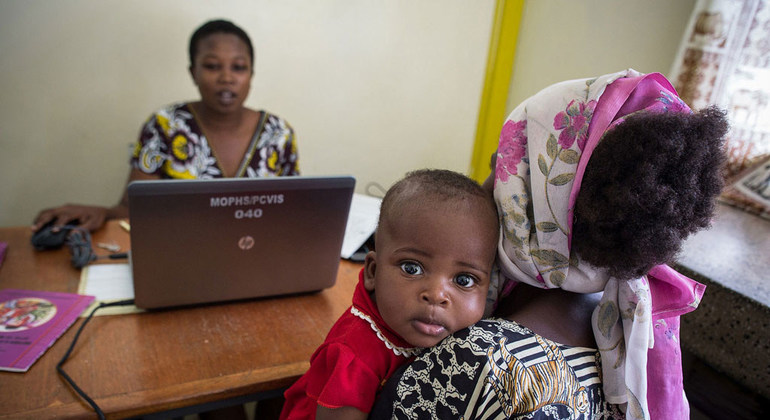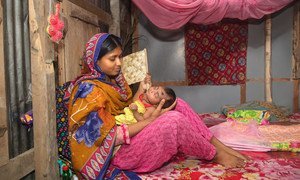‘Forgotten’ pneumonia epidemic kills more children than any other disease
Pneumonia, an entirely preventable disease, kills more children than any other illness in the world, one child every 39 seconds.
But although that statistic is well known, funding to improve survival rates continues to come up short, the UN and partners warned on Tuesday, World Pneumonia Day.
In 2018 alone, pneumonia killed 800,000 children, and while deaths from other infectious diseases, including malaria, and diarrhoea are falling, fatal pneumonia cases are declining at a much slower pace.
Here’s our full story.
Australia wildfires: ‘Get out’ if you can, warn UN weather experts
As Australia’s “catastrophic” and deadly wildfire emergency continues, UN weather experts on Tuesday echoed Government warnings for people to remain vigilant in the face of tinderbox conditions.
In Geneva, the World Meteorological Organization (WMO) noted that dozens of fires are raging, affecting around six million in eastern New South Wales state, and southeast Queensland, amid reports that three people lost their lives in the fires at the weekend.
Citing Australia’s Bureau of Meteorology description of the situation as “evolving and dangerous”, Ms. Nullis said that conditions were likely to remain dry, with little to no rain forecast.
Here’s our full coverage.
UN health agency welcomes Ebola vaccine approval
For the first time, European regulators have approved a vaccine to protect more people from outbreaks like the one happening in the Democratic Republic of the Congo (DRC).
WHO has welcomed the development, calling it a landmark moment for global health.
It is already using the vaccine on a special trial basis in eastern DRC, where the latest Ebola epidemic has claimed nearly 2,200 lives since August 2018.
Licensed doses of the vaccine will be available in mid-2020, according to WHO spokesperson, Christian Lindmeier.
He noted that although the weekly number of Ebola cases has levelled off recently, the risk of it returning to former infection hotspots remains high, with access to these communities essential if the outbreak is to be eradicated.
Child labour and human trafficking remain concern for global supply chains
In the first-ever report of its kind, new data from the UN and partners indicates that a significant share of child labour and human trafficking in global supply chains occurs on the lower-tier production level, namely, activities such as raw material extraction and agriculture.
The study, published Tuesday, estimates that most child labour linked to global supply chain markets occurs in Eastern and South-Eastern Asia (26 per cent), with Latin America and the Caribbean not far behind (22 per cent), followed by Central and South Asia (12 per cent), Sub-Saharan Africa (12 per cent) and Northern Africa and Western Asia (9 per cent).
Director-General of the International Labour Organisation (ILO), Guy Ryder, one of the report authors, said the figures “show the urgent need for effective action to tackle the violations of core labour rights” occurring in this sector.
UN spotlights ‘explosive’ obesity rates, hunger in Latin America and Caribbean
Since 1975, adult obesity in Latin America and the Caribbean region has tripled, while one in four are going hungry, according to figures published by the UN on Tuesday.
“The explosive increase in obesity, which affects 24 percent of the regional population, about 105 million people – almost double the global level of 13.2 percent – not only has huge economic costs, but also threatens the lives of hundreds of thousands”, said Julio Berdegué, Regional Representative for the UN’s Food and Agriculture Organization (FAO).
Improving food labeling, ensuring the safety and quality of food sold on the street and reformulating ingredients of certain products to ensure nutritional value can also aid the growing problem.
More in our story, here.
Economies must remain open, to succeed: IP chief
Technological solutions to global problems are increasingly complex and require countries to cooperate more, not less, the head of the UN’s intellectual property agency said on Tuesday.
Launching a new report from the World Intellectual Property Organization (WIPO), Director General Francis Gurry said that today, “ever larger and more specialized” research teams often collaborate thousands of miles apart.
It is “imperative” that economies remain open in the pursuit of innovation, he said.
According to WIPO, in the early 2000s, teams of inventors produced just over half of all patents; by 2015, this had grown by a quarter. Self-drive car technology is partly responsible for an increased number of innovation hubs around the world, the agency’s report also found, with cities like Berlin and Los Angeles gaining prominence.
While traditional car makers like Ford and Toyota dominate the autonomous vehicle sector, Google is in the top 10 for patent applications – via its subsidiary Waymo – ahead of Nissan, BMW and Hyundai
Listen to or download our audio News in Brief for 12 November on SoundCloud:









